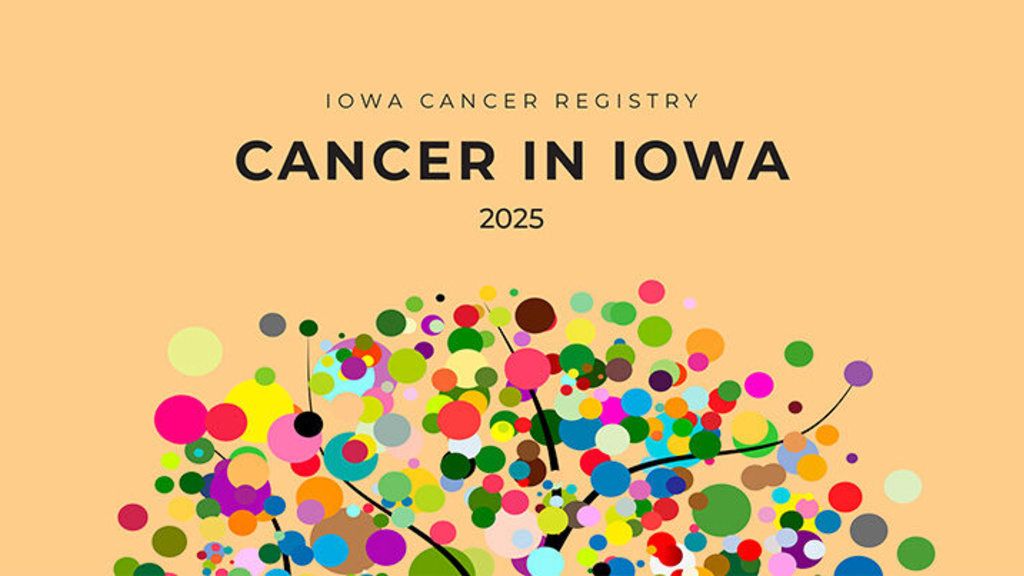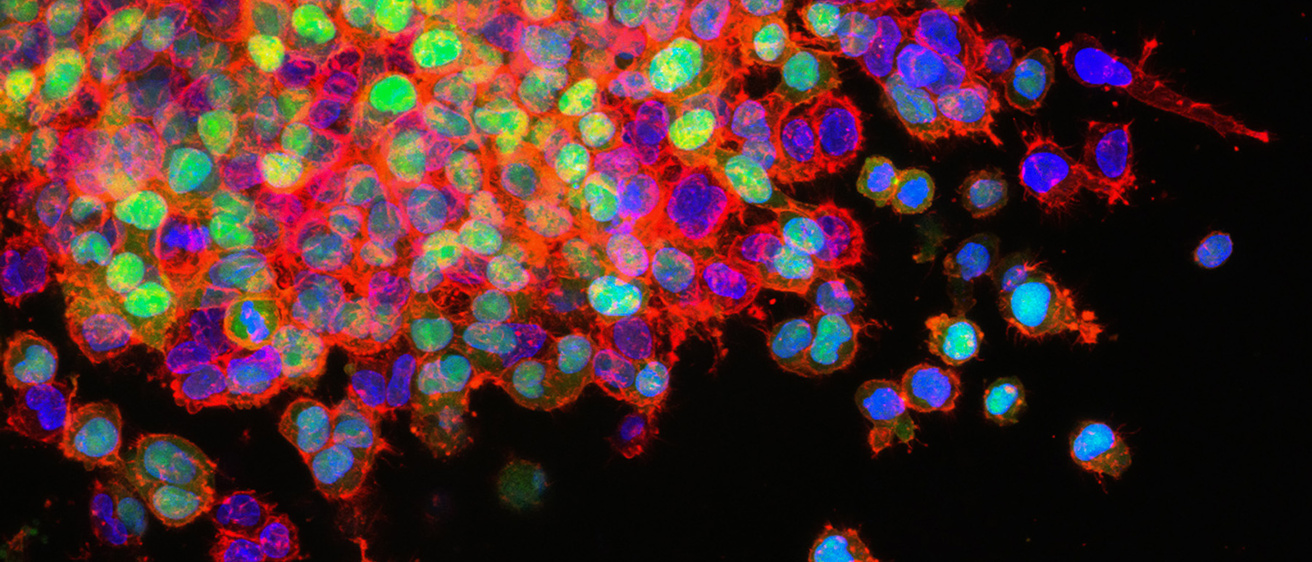For 50 years, the Iowa Cancer Registry, at the University of Iowa, has served the state of Iowa as the trusted source for high-quality cancer data. The registry’s efforts inform research and prompt prevention, screening, and treatment.
Story: Richard C. Lewis
Photography: National Cancer Institute via Unsplash
Published: Feb. 27, 2023
For a half-century, Iowans have been blessed to have a team of dedicated professionals providing a high-quality source of cancer information.
The Iowa Cancer Registry, at the University of Iowa, has been tracking cancer cases, survival rates, and deaths from cancer in the state since 1973. The wealth of data has enabled researchers to learn that Iowa, for example, has the second-highest cancer rate (or incidence) in the United States and the highest rate of head and neck cancer in the country. Such knowledge triggers resources — money, research, and doctors — to focus on how to prevent and better treat cancer.
It’s also unearthed geographical variation with cancer across Iowa, empowering county or regional hospitals to pivot care and support services to match patients’ greatest needs. More broadly, the Iowa Cancer Registry’s work has served as the standard-bearer for cancer information in the Midwest, and the data have been integral to supplying national analyses such as the Agricultural Health Study, a 30-year (and ongoing), comprehensive look at cancer and other health factors affecting farmers.
It’s that kind of data, painstakingly collected over decades, that prompt prevention, screening, and treatment. Those collective efforts yield successes: Iowans have greater awareness about the risks of getting cancer, they’re getting earlier screening, and their survival rates have increased across the board.
“The Iowa Cancer Registry is a unique asset to Iowans, to health care and public health providers across the state, as well as to researchers worldwide,” says Mary Charlton, the registry’s director and associate professor of epidemiology in the UI College of Public Health. “This rich resource is changing the way we identify, diagnose, and treat cancer, and how we care for and support the ever-growing population of those who have survived a cancer diagnosis.”
An important institution in the Heartland
The Iowa Cancer Registry (ICR) began in 1973, two years after President Richard Nixon signed the National Cancer Act, mobilizing the nation’s effort to fight cancer. The registry was one of nine original members of the National Cancer Institute’s Surveillance, Epidemiology, and End Results (SEER) program, and the only cancer data-collection center in the Midwest. As such, the information it collected about cancer in Iowa stood for years as the lone marker in the region for charting the disease.
“We were the only registry within the Heartland contributing our data since 1973, and that’s been our modus operandi ever since,” says Charles Lynch, who led the ICR from 1990 to 2020.
The ICR employed dedicated teams of professionals who fanned out to hospitals and pathology labs in every county, seeking paper records for each person who had been diagnosed with cancer. Staff made connections with cancer centers outside the state, such as the Mayo Clinic, to ensure the registry was collecting the most complete data it could on Iowans with cancer.
“We had to establish relations with hospitals in Iowa and surrounding states to detect all Iowans newly diagnosed with cancer,” Lynch recalls.
The collection challenge eased somewhat when the state legislature voted in 1982 to require cancer cases to be reported to the ICR.

‘Cancer in Iowa' reports
The Cancer in Iowa report is a product of the Iowa Cancer Registry, which collects cancer data on all Iowa residents. The Iowa Cancer Registry is funded in part with federal funds from the National Cancer Institute, National Institutes of Health, Department of Health and Human Services, as well as by the University of Iowa and the state of Iowa.
Yet data are useful only if fully and accurately collected, and trends can be deciphered only after some passage of time. The year after Lynch took charge of the ICR, he directed staff to compile an annual report of cancer’s presence in Iowa.
“The idea was to put together something in a language that a citizen of Iowa could understand,” Lynch says. “We didn’t want to get into just putting out a bunch of data, but to have a prose to accompany it, to explain what was happening.”
The ICR has produced annual reports ever since. They include county-specific estimates for new cancer cases and cancer death projections, the most prevalent types of cancer in Iowa, cancer survivor statistics in each county, and cancer trends in the state.
“We spend a lot of time and effort collecting cancer data, developing reports and analyses to help hospitals across Iowa improve their care or their processes, and understand patient needs and services in that area,” Charlton says. “That exchange empowers hospitals and their communities to make improvements where they’re most needed.”
Those efforts have revealed telling trends about cancer in Iowa. Some are positive: The number of cancer survivors is rising, led by breast-cancer patients. Lung cancer cases have declined markedly, as fewer people smoke.
Others are concerning. Iowa has the second-highest cancer rate in the nation and is the only state where cancer rates are increasing. It also ranks second in cancer rates and third for cancer deaths in the Black population.
“We wouldn’t know that, or we wouldn’t be able to look at disparities like that, if we didn’t have really good data being collected by the registry,” Charlton says.
“You can’t put a value on the partnership. Data is key to growth and success. If you don’t have the data sets and the information, you don’t know where you’re really lacking. To do that, you must have information that is accurate, that is timely, and that you can trust. That’s what the Iowa Cancer Registry does well.”
Registry partnerships strengthen cancer treatment centers in Iowa
The partnership extends beyond acquiring cancer information and sharing it with stakeholders. In Carroll, Iowa, registry personnel are working closely with St. Anthony Regional Hospital, among other rural hospitals throughout Iowa, to help it win accreditation with the American College of Surgeons’ Commission on Cancer.
Through a five-year National Institutes of Health grant, Charlton and her team are helping St. Anthony undergo a full-scale review of its cancer care and its support services for cancer patients. These measures include core cancer services, such as radiation, and vital supplemental services, such as psychosocial, transportation, mental health, nutrition, genetic counseling, navigation, and palliative care. Each requires specific standards to be met, and the ICR staff is helping St. Anthony establish how to meet each standard and collect the data needed to track progress toward fulfilling those standards.
“How do they know where to improve if they don’t have any data that shows them where they’re at and how they’re doing?” Charlton says. “I think we’ve been a lot more proactive than some other registries about giving that data back and helping hospitals like St. Anthony find those opportunities to improve.”
Lori Pietig, director of cancer services at St. Anthony Regional Hospital, says the accreditation would solidify the hospital’s cancer services and would ensure it is meeting high-quality standards in care. This is important, she adds, because 90% of cancer patients at St. Anthony are outside referrals.
“If we are able to check the boxes needed for accreditation and have that stamp of approval, we can be looked at as a partner and that we’ve got resources here in west-central Iowa to take care of our patients,” Pietig says.
“You can’t put a value on the partnership,” Pietig adds. “Data is key to growth and success. If you don’t have the data sets and the information, you don’t know where you’re really lacking. To do that, you must have information that is accurate, that is timely, and that you can trust. That’s what the Iowa Cancer Registry does well.”
“The Iowa Cancer Registry is a unique asset to Iowans, to health care and public health providers across the state, as well as to researchers worldwide. This rich resource is changing the way we identify, diagnose, and treat cancer, and how we care for and support the ever-growing population of those who have survived a cancer diagnosis.”
National and global impact
The ICR’s data have contributed to numerous national cancer studies, enabling federal agencies such as the National Institutes of Health, the Environmental Protection Agency, the Centers for Disease Control and Prevention, the Department of Agriculture, and others to devote resources where the need is greatest.
One example is ICR’s leadership on radon, the naturally occurring, radioactive gas that can permeate residential homes and is the leading cause of lung cancer among nonsmokers. Radon is prevalent in some geographic areas in Iowa, so the ICR in 1993 began the Iowa Radon Lung Cancer Study examining residential radon exposure in the state. The data from that study were pooled with studies in the U.S., Canada, and Europe—and eventually made its way to the World Health Organization, which created a handbook on how countries should handle residential radon.
“That was a project where the information was utilized for the welfare of the planet,” says Lynch, the ICR director at the time, who was involved in the research.
Looking ahead, the ICR aims to leverage advances in data collection, such as with electronic pathology (ePath), that can allow cases to be entered almost as soon as a new cancer has been diagnosed.
“We want to continue to collect really high-quality data in the most efficient way possible because the National Cancer Institute wants the most timely statistics,” Charlton says. “So, a big challenge moving forward is quickly obtaining crucial information, such as cancer site and cancer stage, that can provide accurate, timely information about the cancer burden in Iowa and nationally.”
